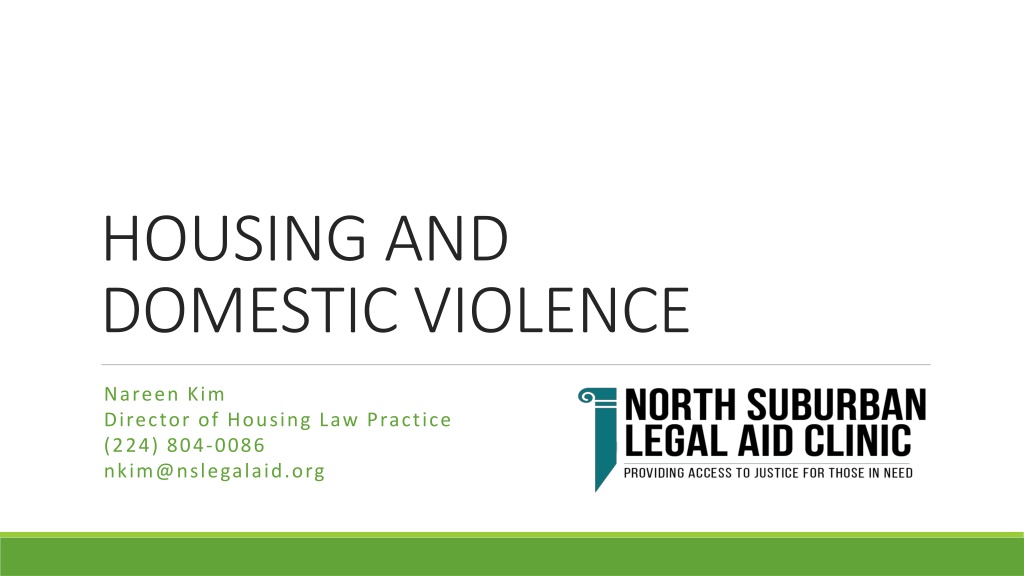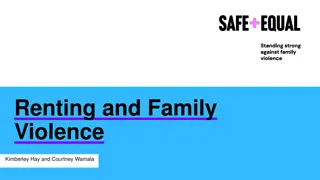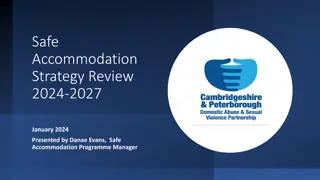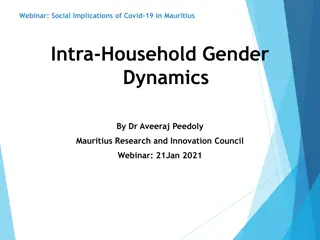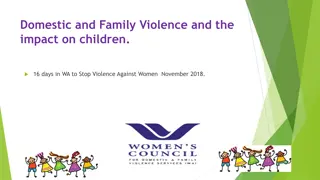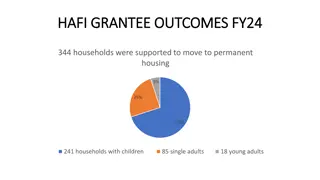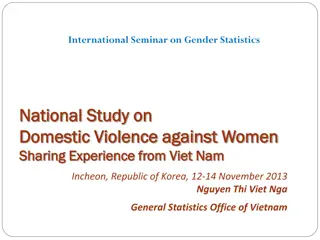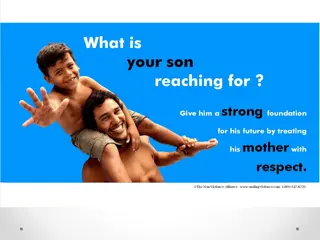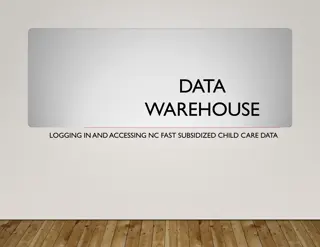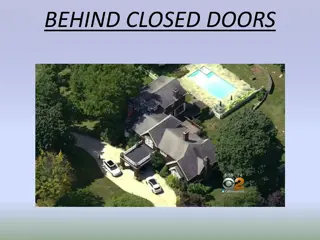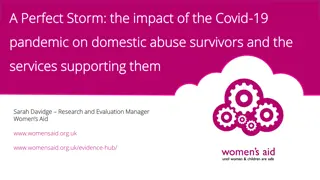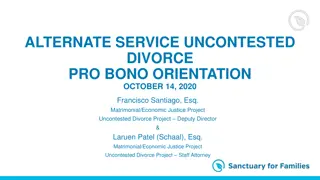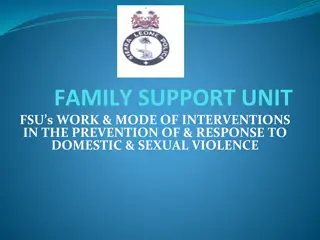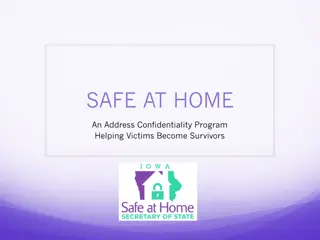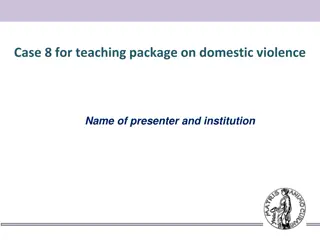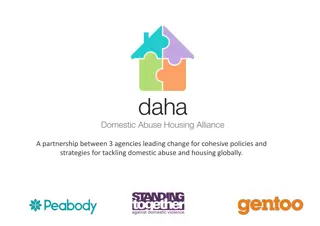Understanding Subsidized Housing Programs for Domestic Violence Survivors
Domestic violence often leads to housing instability, making it crucial for survivors to access safe housing. This article explores the intersection between domestic violence and housing, highlighting the barriers faced by survivors. It delves into the importance of subsidized housing programs, such as Public Housing, Section 8, and Project-Based Vouchers, in providing affordable and safe housing solutions for those affected by domestic violence.
Uploaded on Oct 09, 2024 | 0 Views
Download Presentation

Please find below an Image/Link to download the presentation.
The content on the website is provided AS IS for your information and personal use only. It may not be sold, licensed, or shared on other websites without obtaining consent from the author. Download presentation by click this link. If you encounter any issues during the download, it is possible that the publisher has removed the file from their server.
E N D
Presentation Transcript
HOUSING AND DOMESTIC VIOLENCE Nareen Kim Director of Housing Law Practice (224) 804-0086 nkim@nslegalaid.org
Domestic violence often leads to housing instability and homelessness for women and their children. Intersection Intersection between between Domestic Domestic Violence and Violence and Housing Housing The need for safe housing and the economic resources to maintain safe housing are two of the most pressing concerns among abused women who are planning to or have recently left abusers. As a direct result of the power and control dynamics related to their abuse, survivors often face unique barriers to accessing safe housing.
Barriers to Safe Housing Facing Domestic Barriers to Safe Housing Facing Domestic Violence Survivors Violence Survivors Poor Credit & Ruined Credit History Loss of Steady Employment Often caused by abusers running up credit card bills or lying about paying rent, utilities, childcare and other bills. This affects a survivors ability to pass a landlord background check. Caused when victims are forced to miss work as a result of violence, or are fired as a result of stalking and harassment that occurs at the workplace. Housing Discrimination Loss of Subsidized or Other Affordable Housing The most common cases of this occur when landlords evict victims from housing due to repeated calls to the police or property damage caused by the abuser. Caused by lease or voucher policy violations committed by the abuser.
SUBSIDIZED HOUSING Rent amount is subsidized and is lower than market rent; often 30% of tenant s income Eligibility requirements to get into program Often a waiting list Lease can only be terminated for good cause; endless lease SUBSIDIZED vs. PRIVATE What is the difference between Subsidized housing and Private housing? PRIVATE HOUSING Renting from private landlord Paying contract rent Lease can be terminated without good cause at end of term
Types of Subsidized Housing Types of Subsidized Housing PUBLIC HOUSING Owned and operated by Public Housing Authorities (e.g. CHA, HACC, Lake County Housing Authority) Project-based subsidy (subsidy is attached to unit) SECTION 8 PROJECT BASED Private owners enter into contracts with HUD (Dept. of Housing and Urban Development) Project-based subsidy SECTION 8 TENANT BASED HUD enters into contracts with Public Housing Authorities Tenant-based subsidy (subsidy moves with the tenant) Housing Choice Voucher Program tenant locates housing in private market Project Based Voucher Program project-based subsidy but can get tenant-based after 1 year VASH Veterans Affairs Supportive Housing
TYPES OF SUBSIDIZED HOUSING Types of Subsidized Housing Types of Subsidized Housing OTHER FEDERAL HOUSING PROGRAMS OTHER STATE AND LOCAL PROGRAMS Section 202 Supportive Housing for the Elderly Section 811 Supportive Housing for Persons with Disabilities Section 221(d)(3) Below Market Interest Rate Program Section 236 Program Rent Supplement Program Continuum of Care Program (homeless assistance) HOPWA (Housing Opportunities for Persons with AIDS) Low Income Housing Tax Credit Program HOME Illinois Affordable Housing Program Rental Housing Support Program Bridge Subsidy Program (mental illness) Chicago Low Income Housing Trust Fund
SAFE HOMES ACT 765 ILCS 750/1
The Safe Homes Act is an Illinois law that allows victims of domestic or sexual violence: The right to break a lease without being responsible for rent that accrues during the rest of the lease term The right to change locks to the unit SAFE HOMES ACT What is the Safe Homes Act? Who is covered? The Act applies to tenants who live in: Private rental housing Housing Choice Vouchers Subsidized housing But does NOT apply to public housing
REQUIREMENTS: a credible imminent threat of domestic or sexual violence against the tenant or a member of the household at the premises SAFE HOMES ACT Breaking the Lease - Credible Imminent Threat What the Tenant Must Do: Give written notice to the landlord Prior to or within 3 days of vacating the premises Examples of what would be credible imminent threat: An abuser comes to the tenant s job and the tenant fears he will come to their apartment next An abusive ex-boyfriend finds out where the tenant lives A stalker is parked outside a tenant s unit
REQUIREMENTS: Sexual violence To a tenant or a member of the household At the premises Within the past 60 days SAFE HOMES ACT Breaking the Lease Sexual Violence What the Tenant Must Do: Give written notice to the landlord Prior to or within 3 days of vacating the premises (or as soon thereafter as they can) Include the date of the sexual violence Include one form of evidence supporting the claim of sexual violence: medical, court or police evidence; or statement from an employee of a victim services or rape crisis organization from which the victim sought services
Tenants Rights under Safe Homes Act Tenant s Rights under Safe Homes Act RENT If proper notice is given, the tenant may not be responsible for rent due after leaving the unit. SECURITY DEPOSIT The landlord cannot keep the security deposit to pay for rent accrued after leaving the unit. REFERENCES The landlord cannot disclose to a prospective landlord that the tenant exercised rights under the Safe Homes Act or any information that the tenant provided. Court case for actual damages up to $2,000 for disclosure and attorney s fees and costs EVICTION DEFENSE If the landlord sues them in court for rent due, the tenant has an affirmative defense to nonpayment of rent.
REQUIREMENTS: a credible imminent threat of domestic or sexual violence against the tenant or a member of the household at the premises SAFE HOMES ACT Changing Locks What the Tenant Must Do: WRITTEN LEASE Abuser Not on Lease Written notice from all tenants who have signed as lessees under a written lease Must include at least one form of the following types of evidence: Court or police evidence of domestic or sexual violence Statement from an employee of a victim services, domestic violence, or rape crisis organization from which the victim sought services WRITTEN LEASE Abuser on Lease or ORAL LEASE Must also include a plenary order of protection or a plenary civil no contact order granting the tenant exclusive possession of the premises Written notice not needed from Abuser
What the Landlord Must Do: Landlord has 48 hours to change the locks or give tenant permission to change the locks. If the landlord fails to change the locks within 48 hours, the tenant may change the locks without the landlord s permission. If the landlord takes action to prevent a tenant from changing the locks, tenant can file a court case. SAFE HOMES ACT Changing Locks Landlord s Responsibilities Landlord may charge a reasonable fee for changing the locks. Both parties must make good faith efforts to give the other party the new keys as soon as possible and not later than 48 hours.
Limitations of Safe Homes Act Limitations of Safe Homes Act Does NOT provide a defense to rent that accrued before the tenant vacated and gave notice to the landlord. Does NOT provide a defense to a tenant who chooses to remain in the unit but cannot afford to pay rent.
VAWA VIOLENCE AGAINST WOMEN ACT 42 U.S.C. 13925 AND 42 U.S.C. 14043E
VAWA is a federal law that protects victims of domestic violence, dating violence, sexual assault, and stalking and affiliated individuals (family or household members). Protects victims of violence from being denied entry into public or subsidized housing Protects victims from being evicted from their housing or having their subsidies terminated VAWA What is VAWA? VAWA applies to tenants who live in federally subsidized housing such as: Public Housing Project-based Section 8 Housing Housing Choice Voucher Program Other HUD Programs including: Section 202 Supportive Housing for the Elderly Section 811 Supportive Housing for Persons with Disabilities HOPWA HOME Who is covered?
ADMISSIONS VAWA protects victims of violence from being denied admission into public or subsidized housing because they are victims of violence. Property owners can not use an applicant s history as a victim under VAWA as a reason to refuse housing assistance if they otherwise qualify. VAWA Protections Under VAWA EVICTIONS/TERMINATIONS FROM SUBSIDIES VAWA protects victims from being evicted from their housing or having their subsidies ended because of actual or threatened violence. An incident of actual or threatened domestic violence, dating violence, sexual assault, or stalking shall not be construed as a serious or repeated violation by the victim or good cause for terminating the assistance, tenancy, or occupancy rights of the victim.
If an applicant or tenant represents to the housing provider that they are a victim under VAWA, the housing provider may request in writing that the applicant or tenant submit documentation. The tenant must provide one of the following documents within 14 days: Certification form A document: Signed by an employee, agent, or volunteer of a victim service provider; an attorney, medical professional, or mental health professional from whom the victim has sought assistance; and Signed by the applicant or tenant; and Specifies under penalty of perjury that the professional believes in the occurrence of the incident of domestic violence, dating violence, sexual assault, or stalking that is the ground for protection and that the incident meets the applicable definition A record of a federal, state or local law enforcement agency, court, or administrative court VAWA Documentation
Emergency Transfer Plan Emergency Transfer Plan Housing providers must adopt an emergency transfer plan that provides a tenant who is a victim under VAWA an emergency transfer if: The tenant expressly requests the transfer and Either: The tenant reasonably believes that there is a threat of imminent harm from further violence if the tenant remains in the same unit OR In the case of a tenant who is a victim of a sexual assault, the sexual assault occurred on the premises during the 90 days preceding the date requesting transfer
Remedies Available to Victims Remedies Available to Victims Lease Bifurcation Housing provider may bifurcate a lease or remove a household member from a lease in order to evict, remove, terminate occupancy rights, or terminate assistance to such member who engages in criminal activity directly relating to domestic violence, dating violence, sexual assault or stalking. Following Orders of Protection - If the victim receives an Order of Protection, the housing authority or owner must act according to the court order, especially as it relates to who has a right to the housing, the housing subsidy, or access to the property. Confidentiality any information submitted to a housing provider under VAWA must be maintained in strict confidence.
Limitations of VAWA Limitations of VAWA A housing provider may still terminate assistance or evict a tenant if they can demonstrate an actual and imminent threat to other tenants or those employed at or providing service to the housing provider s property. A housing provider can also still terminate assistance or evict a tenant for lease violations not based on the acts protected by VAWA.
EVICTION PROCESS Notice Filing Court Eviction
Notice Before starting an eviction case, a Landlord must give the tenant a written notice to terminate tenancy. 5 Day Notice: Nonpayment of rent 10 Day Notice: Lease violations 30 Day Notice: Termination of month-to-month tenancy EVICTION PROCESS Notice * Subsidized housing may have other specific requirements for what type of notice is needed and how the notice must be given. * Local ordinances may also have other specific requirements.
Filing of Complaint Only after the notice period ends can a landlord file an eviction Complaint with the Clerk s office. EVICTION PROCESS Filing Service of Summons The landlord will also file a Summons which tells the tenant when the court date is. The Complaint and Summons must be delivered by the Sheriff s office or a special process server.
Court Trial/Return date: The first court date is the trial/return date. A tenant can request a continuance to get an attorney but may not always get one. Eviction Defense: A tenant can raise defenses to the eviction such as: Defective notice/premature filing Waiver Warranty of habitability Immaterial lease violation Retaliation (tenant complained to a governmental authority about landlord s violation of building code, health ordinance) Safe Homes Act Tenant victim of domestic or sexual abuse EVICTION PROCESS Court Settlement: A tenant can also work out a settlement with their landlord such as: Repayment plan Probation Move out with a compliance status date
This form is approved by the Illinois Supreme Court and is required to be used in all Illinois Circuit Courts. STATE OF ILLINOIS, CIRCUIT COURT COUNTY Instructions Directly above, enter the name of the county where the case was filed. Enter the full names of Plaintiff, Defendants, and the case number as listed on the Eviction Complaint. Check the box for Unknown Occupants if it was checked on Eviction Complaint. Unknown Occupants This Order is a judgment against you. It may appear on a background or credit check and affect your ability to rent housing. Do not agree to or sign off on this Order if: You have an agreement with Plaintiff that lets you stay in the property; or Plaintiff has agreed to dismiss this case if you move out by a certain date. Check this box if the judge dismissed any Defendants from the case. Enter the names of those Defendants. 1. Plaintiff is given possession of the property located at: In 1, enter the complete address, including the street direction (N., E., etc.) and unit # or floor. In 2, enter the date and time by which Defendants must move out. 3. Plaintiff may give the sheriff a copy of this Eviction Order. If Defendants do not move by the date and In 3,enter the names of Defendants to be evicted and check the box for Unknown Occupants if it was checked on the Eviction Complaint. Money claim dismissed and Plaintiff may seek this money in the future In 4, check the boxes that apply. If Plaintiff is awarded money, enter the names of Defendants who have been ordered to pay the money. The total judgment amount of $ Sections 1-4 must be completed. The Court is not yet ruling on the money claim. Case continued to for status hearing in courtroom and the Court finds there is no just reason to delay enforcement or appeal of this Eviction Order. Enter the name and contact information of the person completing this Order. Telephone #: Attorney # (if any): For Court Use Only EVICTION ORDER Plaintiff (For example, the landlord or owner): v. Defendants (For example, the tenants or occupants): Case Number Eviction EVICTION PROCESS Eviction If the Tenant loses or agrees to it, the Court will enter an Eviction Order. Notice to Defendants: The following individuals are dismissed as Defendants, and this Order does not apply to them: Street address City 2. Defendants must move out of the property on or before or by Time Unit by 11:59 p.m. The Court can enter a money judgment and/or an order giving possession back to the Landlord on a certain date. State ZIP Date time listed above, the Sheriff is ordered to evict the following Defendants: 4. Plaintiff is owed (check all that apply): No money claimed in Eviction Complaint Unknown Occupants Money claim dismissed and Plaintiff may not seek this money in the future $ in rent or assessments $ in court costs $ in attorneys' fees (if allowed) is entered against the following Defendants: Date Time ENTERED: Name: Address: Date Judge Page 1 of 1 E-O 3500.2 (12/17) Print Save Reset Form
Eviction Enforcement EVICTION PROCESS Eviction If the tenant does not leave by the time listed in the Eviction Order, the landlord can have the Sheriff enforce the eviction. ** Only the Sheriff s office can enforce an eviction. Enforcement In Cook County, no evictions are enforced when the weather is below 15 degrees (or severe weather) and between December 17 - January 2.
Sealing Evictions Sealing Evictions Just having an eviction filed can be a serious obstacle for a tenant looking for housing. Many landlords check court records for prior eviction cases. A money judgment in an eviction case also may show up on a credit report. SEALING Sealing an eviction case means that the public cannot find the case when searching court records. A landlord should not be able to find a sealed eviction case. The case may still appear on a credit report. ALL residential evictions filed between March 9, 2020 and March 21, 2022 should be automatically sealed.
HOUSING REFERRALS TO NSLAC
WHO WE CAN HELP WITH HOUSING PROBLEMS: ELIGIBILITY REQUIREMENTS TYPES OF CASES WE CAN HELP WITH Income eligible - below 250% of the federal poverty level Tenants renting in private or subsidized housing Live in Lake County or North Suburban Cook County Eviction cases must be at the Skokie or Waukegan Courthouse (and possibly Rolling Meadows) CAN represent undocumented Evictions Landlord-tenant disputes Conditions/repairs Breaking a lease Rental assistance applications Illegal lockouts Security deposits Termination from subsidy Reasonable accommodations
HOW TO CONTACT US: North Suburban Legal Aid Clinic 491 Laurel Ave. 2nd Floor Highland Park, IL 60035 (847) 737-4042 www.nslegalaid.org info@nslegalaid.org
